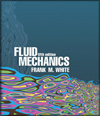
|  |
Table of ContentsPreface xiChapter 1
Introduction 3
1.1 Preliminary Remarks 3
1.2 The Concept of a Fluid 4
1.3 The Fluid as a Continuum 6
1.4 Dimensions and Units 7
1.5 Properties of the Velocity Field 14
1.6 Thermodynamic Properties of a Fluid 16
1.7 Viscosity and Other Secondary Properties 23
1.8 Basic Flow Analysis Techniques 38
1.9 Flow Patterns: Streamlines, Streaklines, and Pathlines 39
1.10 The Engineering Equation Solver 44
1.11 Uncertainty of Experimental Data 45
1.12 The Fundamentals of Engineering (FE) Examination 46
1.13 Problem-Solving Techniques 47
1.14 History and Scope of Fluid Mechanics 47
Problems 49
Fundamentals of Engineering Exam Problems 57
Comprehensive Problems 57
References 59Chapter 2
Pressure Distribution in a Fluid 63
2.1 Pressure and Pressure Gradient 63
2.2 Equilibrium of a Fluid Element 65
2.3 Hydrostatic Pressure Distributions 67
2.4 Application to Manometry 74
2.5 Hydrostatic Forces on Plane Surfaces 78
2.6 Hydrostatic Forces on Curved Surfaces 84
2.7 Hydrostatic Forces in Layered Fluids 86
2.8 Buoyancy and Stability 89
2.9 Pressure Distribution in Rigid-Body Motion 94
2.10 Pressure Measurement 102
Summary 106
Problems 106
Word Problems 128
Fundamentals of Engineering Exam Problems 129
Comprehensive Problems 130
Design Projects 131
References 132Chapter 3
Integral Relations for a Control Volume 135
3.1 Basic Physical Laws of Fluid Mechanics 135
3.2 The Reynolds Transport Theorem 139
3.3 Conservation of Mass 147
3.4 The Linear Momentum Equation 153
3.5 The Angular Momentum Theorem 166
3.6 The Energy Equation 172
3.7 Frictionless Flow: The Bernoulli Equation 182
Summary 191
Problems 192
Word Problems 220
Fundamentals of Engineering Exam Problems 221
Comprehensive Problems 222
Design Project 223
References 223Chapter 4
Differential Relations for Fluid Flow 225
4.1 The Acceleration Field of a Fluid 225
4.2 The Differential Equation of Mass Conservation 227
4.3 The Differential Equation of Linear Momentum 234
4.4 The Differential Equation of Angular Momentum 240
4.5 The Differential Equation of Energy 242
4.6 Boundary Conditions for the Basic Equations 244
4.7 The Stream Function 249
4.8 Vorticity and Irrotationality 257
4.9 Frictionless Irrotational Flows 259
4.10 Some Illustrative Plane Potential Flows 264
4.11 Some Illustrative Incompressible Viscous Flows 269
Summary 278
Problems 278
Word Problems 288
Fundamentals of Engineering Exam Problems 289
Comprehensive Problems 289
References 290Chapter 5
Dimensional Analysis and Similarity 293
5.1 Introduction 293
5.2 The Principle of Dimensional Homogeneity 296
5.3 The Pi Theorem 302
5.4 Nondimensionalization of the Basic Equations 309
5.5 Modeling and Its Pitfalls 318
Summary 328
Problems 329
Word Problems 337
Fundamentals of Engineering Exam Problems 337
Comprehensive Problems 338
Design Projects 339
References 340Chapter 6
Viscous Flow in Ducts 343
6.1 Reynolds Number Regimes 343
6.2 Internal versus External Viscous Flows 348
6.3 Head Loss—The Friction Factor 351
6.4 Laminar Fully Developed Pipe Flow 353
6.5 Turbulence Modeling 355
6.6 Turbulent Pipe Flow 361
6.7 Three Types of Pipe Flow Problems 369
6.8 Flow in Noncircular Ducts 375
6.9 Minor Losses in Pipe Systems 384
6.10 Multiple-Pipe Systems 393
6.11 Experimental Duct Flows: Diffuser Performance 399
6.12 Fluid Meters 404
Summary 425
Problems 426
Word Problems 443
Fundamentals of Engineering Exam Problems 444
Comprehensive Problems 445
Design Projects 447
References 447Chapter 7
Flow Past Immersed Bodies 451
7.1 Reynolds Number and Geometry Effects 451
7.2 Momentum Integral Estimates 455
7.3 The Boundary Layer Equations 458
7.4 The Flat-Plate Boundary Layer 461
7.5 Boundary Layers with Pressure Gradient 470
7.6 Experimental External Flows 476
Summary 503
Problems 503
Word Problems 516
Fundamentals of Engineering Exam Problems 517
Comprehensive Problems 517
Design Project 518
References 519Chapter 8
Potential Flow and Computational Fluid Dynamics 523
8.1 Introduction and Review 523
8.2 Elementary Plane Flow Solutions 526
8.3 Superposition of Plane Flow Solutions 528
8.4 Plane Flow past Closed-Body Shapes 535
8.5 Other Plane Potential Flows 544
8.6 Images 549
8.7 Airfoil Theory 551
8.8 Axisymmetric Potential Flow 563
8.9 Numerical Analysis 568
Summary 583
Problems 583
Word Problems 594
Comprehensive Problems 594
Design Projects 596
References 596Chapter 9
Compressible Flow 599
9.1 Introduction 599
9.2 The Speed of Sound 604
9.3 Adiabatic and Isentropic Steady Flow 606
9.4 Isentropic Flow with Area Changes 612
9.5 The Normal Shock Wave 619
9.6 Operation of Converging and Diverging Nozzles 627
9.7 Compressible Duct Flow with Friction 632
9.8 Frictionless Duct Flow with Heat Transfer 644
9.9 Two-Dimensional Supersonic Flow 649
9.10 Prandtl-Meyer Expansion Waves 659
Summary 671
Problems 672
Word Problems 685
Fundamentals of Engineering Exam Problems 685
Comprehensive Problems 686
Design Projects 687
References 688Chapter 10
Open-Channel Flow 691
10.1 Introduction 691
10.2 Uniform Flow; The Chézy Formula 697
10.3 Efficient Uniform-Flow Channels 702
10.4 Specific Energy; Critical Depth 704
10.5 The Hydraulic Jump 711
10.6 Gradually Varied Flow 716
10.7 Flow Measurement and Control by Weirs 724
Summary 731
Problems 731
Word Problems 742
Fundamentals of Engineering Exam Problems 743
Comprehensive Problems 743
Design Projects 744
References 745Chapter 11
Turbomachinery 747
11.1 Introduction and Classification 747
11.2 The Centrifugal Pump 750
11.3 Pump Performance Curves and Similarity Rules 756
11.4 Mixed- and Axial-Flow Pumps: The Specific Speed 766
11.5 Matching Pumps to System Characteristics 772
11.6 Turbines 779
Summary 792
Problems 793
Word Problems 804
Comprehensive Problems 804
Design Project 806
References 806Appendix A Physical Properties of Fluids 808
Appendix B Compressible Flow Tables 813
Appendix C Conversion Factors 830
Appendix D Equations of Motion in Cylindrical Coordinates 832
Appendix E Introduction to EES 834
Answers to Selected Problems 846
Index 853 |
|
|